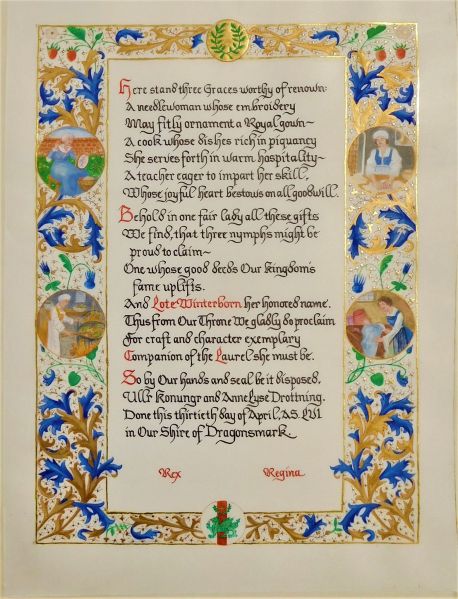Beloved knight, like you I have received
Gifts from our sojourn in the Dragon’s realm
And yearning to repay the good, conceived
A hope that, girded in armour and helm,
You might attain the acme of renown
And we two share the burden of the Crown
For benefit of all who dwell upon this ground.
So now we stand together as above
Our heads a mountain low’rs, as it would dare
Us to ascend; and fearless in our love
We set forth down below; in upper air
What mysteries await, we must surmise–
The summit wreathed in mist evades our eyes
Yet from its top, we shall wonder at azure skies.
The knightly code that shapes your high ideals
Has shaped me too; your strength has strengthened me.
So tempered now, as fire the blade anneals,
We true companions, champions each to each,
Strive onward to achieve the final climb
With honor that makes victory sublime,
And carve our names in deeds that shall not fade with time.
Process notes
The working title of this poem was “Eleanor’s Reply.” I wrote it as part of the Crown Tourney Praise Poetry project a year after “The Gift,” about the same couple. It brought some additional challenges.
To begin with, I was effectively repeating a project. Once again I had Jaime fighting in Crown Tourney as Eleanor’s champion. Yet I had to find something new to say. On top of that, I was writing a sequel to a very successful poem, both in terms of its effect on its audience and of my own satisfaction with the work. I did not want to do less well the second time. I felt that pressure, and it took a few false starts to get my head out of perfectionism and into creation.
As with “The Gift,” I chose to use a relatively complex form, and one that is not particularly well known. I had recently completed another poem in rhyme royal and had the seven-line stanza on my mind. I started to write this poem in the same form, with the conventional pentameter. But then I created a hexameter line that I couldn’t find a way to rephrase into pentameter, but liked too much to give up. So I decided my seven-line stanza would keep its rhyme royal roots, but have variations in the rhyme scheme and line length. (A hexameter line at the end of a pentameter stanza occurs, for example, in Edmund Spenser’s The Faerie Queene.)
Like “The Gift,” this poem is based on private thoughts expressed by its speaker, with poetic license taken by me. The central metaphor was my own construction, and I selected the final title to highlight it, as well as to parallel “The Gift.”












